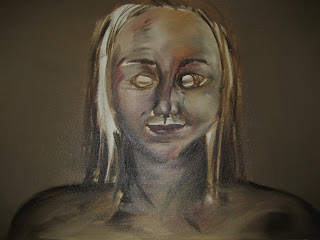I was quite enthused to start portraits. The human face seems to be something challenging, having so many features and slight angles and lines created from the bone and muscle beneath. I was anxious to learn the relationships of the face and learn a foundation of how to begin this challenge. While watching the demo before starting our own portraits, I began thinking how intriguing it would be to be able to see the x-rays of paintings. Viewers only see the final product of a painting, but they do not see all the steps and stages it takes to reach that point. Many artist may prefer this, but I think it is so intriguing being able to follow a person's thoughts and signs of growth or understanding of something by following the process it took for them to reach a point. Anyway, after learning some basic principles of the face and given direction on how to begin we got started on our canvases.
The first day I was in a painting mood, and was just having fun applying the paint to my canvas. I experimented with colors and application to understand how they could work together to for flesh. I didn't get too caught up in accuracy of both color and form at this point (seen in stages 1-5), but rather I just was going through more of an experimentation period.









No comments:
Post a Comment